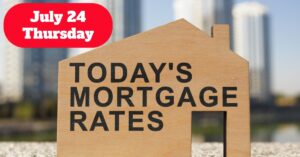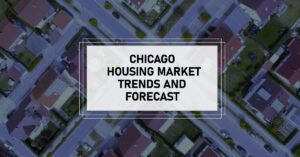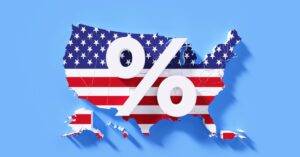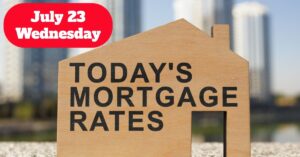Mortgage rates today — July 24, 2025 — show a small decrease in the 30-year fixed mortgage rate, down slightly from last week at 6.86%. Refinance rates also dipped, with the national 30-year fixed refinance rate now at 7.06%. However, 15-year fixed rates and some ARM (Adjustable Rate Mortgage) products saw mixed changes. These movements reflect ongoing economic pressures and Federal Reserve policies that continue to influence borrowing costs.
Mortgage Rates Today July 24, 2025: Rates Drop Across the Board, 30-Year FRM at 6.86%
Key Takeaways
- 30-year fixed mortgage rates edged down to 6.86%, a slight dip from 6.88% the week before.
- 15-year fixed mortgage rates rose marginally to 5.90%; 5-year ARM rates decreased to 7.63%.
- Refinance rates followed a similar pattern: 30-year fixed refinance rate at 7.06% (down from 7.11%).
- Conforming loan rates remain generally lower than government-backed loan rates.
- Experts forecast mortgage rates to hover around the mid-6% range through 2025, with possible further declines in 2026.
- Federal Reserve policies and economic factors continue to pressure mortgage rates, with cautious optimism for rate cuts later this year.
Understanding Today’s Mortgage Rates: What’s Happening?
On July 24, 2025, the average national 30-year fixed mortgage rate sits at 6.86%, down 2 basis points from the previous week’s 6.88%. While this may seem like a minor change, it is significant because rates have hovered near their highest levels in years, impacting affordability for homebuyers.
The 15-year fixed mortgage rate ticked up by 3 basis points to 5.90%, and the 5-year ARM rate dropped 6 basis points to 7.63%. ARM loans often attract borrowers seeking lower initial rates but come with the risk of rate adjustments later. These subtle shifts reflect a dynamic market still influenced by inflation concerns, economic policies, and Federal Reserve actions.
Table 1: Current National Average Mortgage Rates (July 24, 2025)
| Loan Type | Rate | Weekly Change | APR | APR Change |
|---|---|---|---|---|
| 30-Year Fixed | 6.86% | Down 0.02% | 7.31% | Down 0.03% |
| 20-Year Fixed | 6.28% | Down 0.43% | 6.76% | Down 0.27% |
| 15-Year Fixed | 5.90% | Down 0.03% | 6.19% | Down 0.03% |
| 10-Year Fixed | 5.72% | Down 0.31% | 6.09% | Down 0.03% |
| 7-Year ARM | 6.44% | Down 1.13% | 7.50% | Down 0.46% |
| 5-Year ARM | 7.63% | Down 0.20% | 8.02% | Down 0.10% |
Source: Zillow Mortgage Data, July 24, 2025
Comparing Conforming Mortgage Rates and Government Loan Rates
Mortgage rates today vary significantly between conforming loans and government-backed loans (FHA, VA):
- Conforming loans are those that meet the guidelines set by Fannie Mae and Freddie Mac—usually for loan amounts up to $726,200 (in most areas in 2025).
- Government loans, such as FHA (Federal Housing Administration) and VA (Veterans Affairs) loans, typically serve borrowers with lower credit scores or limited down payments.
Government-backed loan rates are generally higher than conforming loan rates now.
| Loan Type | Rate | Weekly Change | APR | APR Change |
|---|---|---|---|---|
| 30-Year Fixed FHA | 7.75% | Up 0.48% | 8.79% | Up 0.49% |
| 30-Year Fixed VA | 6.25% | Down 0.11% | 6.48% | Down 0.10% |
| 15-Year Fixed FHA | 5.75% | Up 0.28% | 6.71% | Up 0.24% |
| 15-Year Fixed VA | 5.80% | Down 0.10% | 6.16% | Down 0.08% |
The higher FHA rates reflect the increased risk lenders associate with these loans, partly due to upfront mortgage insurance fees. Meanwhile, VA loans offer competitive rates close to or better than conforming loans as they carry government guarantees. Borrowers should analyze which programs best suit their financial profile beyond just the rates.
Current Refinance Rates — What You Need to Know
Refinancing can be a strategic move to reduce monthly payments or change loan terms. Today, average national refinance rates stand as follows:
| Loan Type | Rate | Weekly Change | APR | APR Change |
|---|---|---|---|---|
| 30-Year Fixed Refinance | 7.06% | Down 0.05% | N/A | N/A |
| 15-Year Fixed Refinance | 5.87% | Down 0.02% | N/A | N/A |
| 5-Year ARM Refinance | 7.96% | Up 0.03% | N/A | N/A |
Source: Zillow Mortgage Data, July 24, 2025
Even with current rates slightly lower this week, refinance rates are generally higher than purchase mortgage rates. This often happens because refinance loans involve different risk factors and fees.
Calculating What These Rates Mean for Homebuyers
Let’s say you are looking to buy a home priced at $350,000 with a 20% down payment ($70,000), so you finance $280,000.
- At 6.86%, a 30-year fixed mortgage on $280,000 yields a monthly principal and interest payment of about $1,847.
- If rates drop by just 0.50% to 6.36%, monthly payments fall to approximately $1,737, nearly $110 less per month.
While that difference might seem small month to month, it adds up to over $1,300 in annual savings — money that could be used for other expenses or investments.
Related Topics:
Mortgage Rates Trends as of July 23, 2025
Mortgage Rates Predictions for the Next 30 Days: July 3-August 3
Mortgage Rate Predictions for the Next 3 Years: 2026, 2027, 2028
Will Mortgage Rates Drop? Expert Forecasts & Predictions
Several authoritative sources suggest that mortgage rates are expected to ease somewhat during the rest of 2025 and into 2026, but they will likely remain elevated by historical standards:
- National Association of Realtors (NAR) projects an average mortgage rate around 6.4% in the second half of 2025, dropping to 6.1% in 2026 — tied closely to inflation and Fed policy changes. NAR’s Chief Economist Lawrence Yun describes mortgage rates as a key factor—or “magic bullet”—that will affect housing affordability and sales volumes (NAR Realtors Legislative Meeting, 2025).
- Realtor.com Housing Forecast anticipates a slow easing of mortgage rates back toward prior-year levels, expecting the rate to dip near 6.4% by year-end 2025, which could fuel slightly improved home sales and a gentle slowdown in price growth.
- Fannie Mae’s outlook foresees mortgage rates settling around 6.5% in 2025 and dropping to approximately 6.1% in 2026, aligned with mild GDP growth assumptions and inflation expectations.
- Mortgage Bankers Association expects 30-year mortgage rates to hover near 6.7% through late 2025 and gently ease to about 6.3% by 2026, citing persistent inflation risks as the main factor keeping rates elevated.
- Morgan Stanley strategists suggest a possible decline in rates linked to anticipated lower Treasury yields if economic growth slows. They highlight how even modest rate drops (e.g., from 7% to 6.25%) can significantly boost housing affordability.
- Freddie Mac resonates with a similar outlook: While rates have stayed higher than expected during 2024 and early 2025, buyers and sellers may act sooner amid expectations that rates won't fall drastically anytime soon.
The Federal Reserve’s Influence on Mortgage Rates
The Federal Reserve dramatically shapes mortgage rates by setting monetary policy rates and influencing Treasury yields, on which mortgages are often priced.
- After cutting the federal funds rate by 1% in late 2024, the Fed held rates steady through June 2025.
- The Fed signals potential rate cuts later in 2025, but timing remains uncertain and controversial among policymakers.
- The “dot plot” forecasts the federal funds rate falling to about 3.9% by year-end 2025, with further easing expected in 2026 and beyond.
- Tariffs and inflation remain wild cards influencing policy decisions.
- The Fed’s next meeting on July 30, 2025, will be closely watched for rate guidance.
Mortgage rates mirror these policies. After peaking around 6.8% in mid-2025, analysts expect rates to decline slowly, potentially reaching the 5% range by 2028 if the Fed consistently cuts rates as anticipated.
Summary Table: Mortgage Rate Trends and Forecasts
| Source | 2025 Mortgage Rate Outlook | 2026 Forecast | Notes |
|---|---|---|---|
| National Association of Realtors (NAR) | ~6.4% in H2 2025 | ~6.1% | Linked to inflation and Fed cuts |
| Realtor.com | Dip to ~6.4% by end of 2025 | Slow price growth expected | Moderate home sales forecast |
| Fannie Mae | Ends 2025 near 6.5% | ~6.1% | Impact of GDP growth outlook |
| Mortgage Bankers Association | ~6.7% through September 2025 | 6.3% range for 2026 | Persistent inflation concerns |
| Morgan Stanley | Potential slight fall with Treasury yields | Further drop if GDP slows | Positive for affordability |
| Freddie Mac | Higher than expected, slight easing | Moderate price increases, more sales | Rate lock-in effect to lessen |
Final Thoughts on Today’s Mortgage Rates and Housing Market
From my observation, the current mortgage rates feel like a balancing act between economic uncertainty and buyer optimism. The slight decline in the 30-year fixed rate to 6.86% might not seem dramatic, but it signals that lenders are cautiously responding to evolving economic signals.
Refinance remains a mixed proposition—while rates have eased a bit, they remain high enough to dissuade widespread refinancing unless borrowers have significantly higher original rates or want to switch loan types.
The comparative rate differences between conforming and government loans underscore the complexity each borrower faces: Lower credit scores or smaller down payments often mean higher rates and insurance costs, which can affect a buyer’s ability to close on a home.
Looking ahead, many experts hint at a gradual improvement in affordability, driven mainly by small downward movements in rates and increased home sales volume. But the Federal Reserve’s choices around inflation and rate cuts will be the dominant forces shaping the market.
If you’re watching mortgage rates today and wondering when or how they might move, it’s clear that modest decreases are anticipated, but large drops remain unlikely in 2025. The housing market will continue to adjust slowly rather than leap, making timing and personal finances more critical than ever.
Invest Smarter in a High-Rate Environment
With mortgage rates remaining elevated this year, it's more important than ever to focus on cash-flowing investment properties in strong rental markets.
Norada helps investors like you identify turnkey real estate deals that deliver predictable returns—even when borrowing costs are high.
HOT NEW LISTINGS JUST ADDED!
Connect with a Norada investment counselor today (No Obligation):
(800) 611-3060
Also Read:
- Will Mortgage Rates Go Down in 2025: Morgan Stanley's Forecast
- Mortgage Rate Predictions 2025 from 4 Leading Housing Experts
- 30-Year Fixed Mortgage Rate Forecast for the Next 5 Years
- 15-Year Fixed Mortgage Rate Predictions for Next 5 Years: 2025-2029
- Will Mortgage Rates Ever Be 3% Again in the Future?
- Mortgage Rates Predictions for Next 2 Years
- Mortgage Rate Predictions for Next 5 Years
- Mortgage Rate Predictions: Why 2% and 3% Rates are Out of Reach
- How Lower Mortgage Rates Can Save You Thousands?
- How to Get a Low Mortgage Interest Rate?
- Will Mortgage Rates Ever Be 4% Again?










